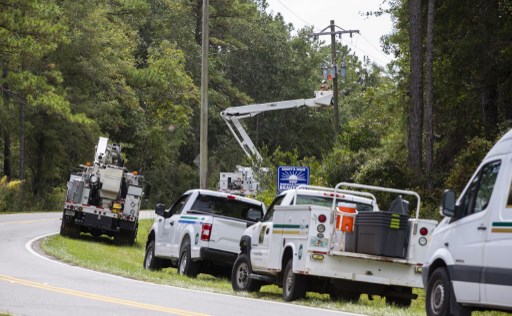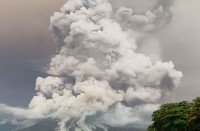
by Brendan SMIALOWSKI / with Leila Macor in Miami
Agence France Presse
PANAMA CITY, United States (AFP) — Michael is now forecast to slam ashore on Florida’s Gulf Coast as a Category 4 hurricane, bringing a surge of up to 13 feet (four meters) in what could be the worst storm there in decades.
As of late Tuesday, Michael was packing maximum sustained winds of nearly 125 miles per hour (205 kilometers) as it aimed for the Florida Panhandle, a finger-shaped strip of land on the Gulf of Mexico.
The storm was expected to make landfall on Wednesday, bringing hurricane force winds and heavy rainfall, the Miami-based National Hurricane Center (NHC) said. It will then move across the southeastern US for another day or so as it heads toward the Atlantic.
At 11:00 pm Eastern time (0300 GMT) it said Michael was still gaining strength and forecast to become a Category 4 hurricane before it comes ashore on the Panhandle or the Big Bend area, which links the former to the peninsula jutting south.
After that advisory, Florida’s governor Rick Scott urged people to obey evacuation orders.
“Families under mandatory evacuation in the Panhandle and Big Bend need to move inland RIGHT NOW,” Scott tweeted. “The decisions you & your family make over the coming hours could be the difference between life & death.”
“#Michael could be one of the worst hurricanes to ever strike the Florida Big Bend/Florida Panhandle region,” former NHC center director Rick Knabb added.
Scott has activated 2,500 members of the National Guard and warned Michael could be the most destructive storm to hit the Florida Panhandle in decades.
President Donald Trump issued an emergency declaration for the state, freeing up federal funds for relief operations and providing the assistance of the Federal Emergency Management Agency (FEMA).
“It is imperative that you heed the directions of your State and Local Officials. Please be prepared, be careful and be SAFE!” Trump tweeted.
State officials issued disaster declarations in Alabama and Georgia, both of which are also expected to feel the impact from the storm.
As of 0300 GMT, Michael was about 220 miles (355 kilometers) south of Panama City and moving north at 12 miles per hour (19 kph).
– Flash flood, tornado warnings –
The NHC said some areas of the Florida coast could expect storm surges of nine to 13 feet and as much as a foot of rain.
The heavy rains could cause flash floods, the NHC said, and spawn tornados in northwestern Florida.
About 120,000 residents were under mandatory evacuation orders in Bay County in the panhandle, a low-lying area of beachfront resorts and retirement communities.
In other areas, residents of mobile homes were urged to leave.
Michael was forecast to have the power to uproot trees, block roads and knock out power for days when it hits Florida. It is expected to weaken as it moves up into the southeastern United States.
The storm is a now Category 3 out of five on the Saffir-Simpson hurricane wind scale.
Drivers waited in long lines at gas stations and residents hurried to fill sandbags, while tolls were suspended on some roads to aid movement ahead of the storm’s landfall.
“Since 6:00 am it’s been backed up. We’re just now running out of regular (gasoline),” Danny Hess, an employee at a gas station in Panama City, told local WJHG television.
The Carolinas are still recovering from Hurricane Florence, which left dozens dead and is estimated to have caused billions of dollars in damage last month.
It made landfall on the coast as a Category 1 hurricane on September 14 and drenched some parts of the state with 40 inches of rain.
Last year saw a string of catastrophic storms batter the western Atlantic — including Irma, Maria and Harvey, which caused a record-equaling $125 billion in damage when it flooded the Houston metropolitan area.
Scientists have long warned that global warming will make storms more destructive, and some say the evidence for this may already be visible.
At their most fearsome, these low-pressure weather fronts pack more power than the energy released by the atomic bomb that levelled Hiroshima.
© Agence France-Presse







